Discover the Unique Stories Behind America’s State Trees & Flowers Part 1: The Northeast
Introduction
Welcome to the Northeast! This region is known for its landscapes, deep history, and unique culture. From the rocky shores of New England to the gentle hills of the Mid-Atlantic, each state in this area has chosen official trees and flowers that reflect its natural legacy. These symbols, from the toughest pines to the smallest wildflowers, offer more than just state pride; they give us a look into the wildlife and culture of some of America’s oldest areas. Join us as we explore these natural symbols, the stories of their selection, and how they represent the Northeast’s unique identity.
New England
New England ‘s six states each boast unique state trees and flowers that reflect the diverse nature and culture found within them. From Maine’s rocky shores to Vermont’s lush mountains, each state has picked a tree and flower that capture its essence. In this section, we’ll explore the chosen trees and flowers of New England, uncovering the stories behind their selection and their significance to each state’s identity.
CONNECTICUT

A White Oak Tree Resembling the Charter Oak – Image by Candace Freeland from Pixabay
The Charter Oak, Connecticut’s state tree, was more than just a plant—it was an important part in the state’s history. This giant white oak stood in Hartford for hundreds of years. It became famous in 1687 when it became an unlikely hiding spot for Connecticut’s charter, keeping it safe from the King’s men. This act of defiance turned the tree into a symbol of American independence. Even though the tree fell in a storm in 1856, its legacy lives on. Its wood was used to make important objects, like a chair that sits in the state capitol. There is also a descendant of this tree growing in the capital, grown from one of the Charter Oak’s acorns. You can also spot an image of this legendary tree on Connecticut’s state quarter! Today, the Charter Oak is a reminder of Connecticut’s history and enduring spirit of freedom, bridging the gap between the past and the present.
While the Charter Oak represents Connecticut’s historical legacy, another natural symbol embodies the state’s rugged beauty. Connecticut’s state flower, the mountain laurel, is a tough yet charming bush that’s been turning heads since 1907. This year-round beauty thrives in the rocky, shaded areas of the Nutmeg State. It blooms in late spring, putting on a dazzling show with star-shaped pink-and-white flowers. While Native Americans used it for making tools, today we appreciate its beauty—but be careful, because all parts of this plant are toxic if eaten!
MAINE
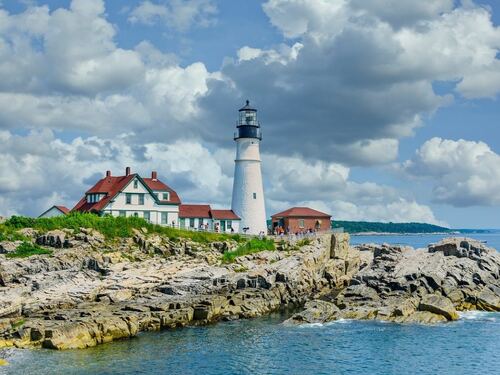
An Iconic Maine Lighthouse Scene – Image by Mohan Nannapaneni from Pixabay
The eastern white pine is Maine’s state tree. It is the biggest conifer in the northeastern United States, earning the nickname “The King of the Forest.” This tree is known for growing fast, usually growing a foot taller per year and much wider than average. This quick growth helps it become a dominant presence in Maine’s forests. The tree’s reproductive cycle is a sign of nature’s patience, since it takes two years for this tree’s pinecones to fully mature. These cones are big, usually between 4-8 inches long, and serve as important food sources for various wildlife. The needles of the eastern white pine are also distinctive, growing in clusters of five needles that range from 3-5 inches long. These needles have a unique color: They appear bluish green, but with one side being white. This makes the tree look silvery when the wind blows. These colors along with its towering presence make it a striking feature of Maine’s landscape. This helps it to embody the state’s natural beauty and the history of the forest.
Interestingly, Maine’s state flower comes from its state tree: The white pinecone and tassel from the eastern white pine tree. The pinecone acts as the “flower,” while the tassel makes the pollen. This choice reflects the importance of the forest to Maine. The pinecone’s gummy resin is known to have a nice smell. This resin also protects the tree from bugs and helps to heal its wounds. Unlike other plants, pine trees don’t use colorful flowers to reproduce. Instead, they have separate male and female cones. The male cones make pollen, and the female cones make seeds once the pollen reaches them. This way of creating new trees has worked well for pine trees for millions of years in many different places. By choosing the white pinecone and tassel as its state flower, Maine celebrates the beauty and importance of its iconic pine trees.
MASSACHUSSETS

A Cluster of White Mayflowers – Image by Annette Meyer from Pixabay
The American elm, Massachusetts’ state tree since 1941, embodies both the state’s natural history and the strength of its people. These majestic trees are known for their vaselike shape and arching canopy. These trees once grew along many streets and parks, creating beautiful tunnels loved by residents and visitors alike. This tree can grow up to one hundred feet tall and can live for centuries in ideal conditions. These trees are known for their jagged leaves that turn golden in the fall. Despite nearly dying out because of Dutch elm disease in the mid-1900s, this species of tree has proven itself to be strong. Thanks to conservation efforts and the development of trees that are resistant to the disease, the species has managed to spring back, though not as much as before. It was historically valued for its strong, dense wood, which was used to make furniture and ships. The American elm continues to be a symbol of the state’s commitment to preservation and the enduring spirit of its people. While its comeback is encouraging, the tree’s story is a reminder of the delicate balance between human development and nature conservation.
While the American elm represents Massachusetts’ resilience, another plant symbolizes the state’s historical roots and the promise of new beginnings. The mayflower, Massachusetts’ state flower since 1918, is also known as the trailing arbutus or the ground laurel. This low-growing plant is among the first to bloom in spring; its pink or white flowers often peek through the late winter snow. It was named after the Mayflower, the ship that brought the Pilgrims to Plymouth in 1620. Native to eastern North America, the mayflower was well known to the Native Americans, who used it for medicine. While its early blooming and strength in harsh conditions have made it a symbol of hope for many, the mayflower does face some challenges today. Things like losing its habitat and over-collection have led to conservation efforts to protect this beloved flower. Despite this, the mayflower’s appearance in the forests of Massachusetts continues to announce the arrival of spring, connecting people to both their natural environment and cultural history.
NEW HAMPSHIRE
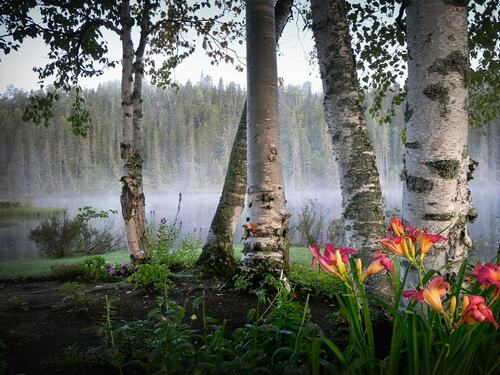
Paper Birch Trees Near a Misty Pond – Image by Alain Audet from Pixabay
The white birch, also known as the paper birch, was designated as New Hampshire’s state tree in 1947. This iconic tree is easy to spot with its peeling white bark that looks like paper. Native to northern North America, the white birch thrives in New Hampshire’s cool climate and is a common sight across the state’s forests and landscapes. These trees typically grow to heights of forty to fifty feet, though some can reach up to eighty feet tall. In the fall, their leaves turn a beautiful golden yellow, adding vibrant color to New Hampshire’s fall scenery. Beyond its aesthetic appeal, Native Americans and early settlers found many uses for the white birch, using its bark for canoes, containers, and even writing material. This tree reminds us of New Hampshire’s history and shows us how one plant can be useful in so many ways.
The purple lilac was adopted as New Hampshire’s state flower in 1919, making it one of the earlier state flower designations in the United States. This fragrant shrub, originally native to the Balkan Peninsula in southeastern Europe, was introduced to North America by early colonists and has since become a beloved feature of New Hampshire’s landscape. The purple lilac typically blooms in May, producing dense clusters of small four-petaled flowers that range in color from light lavender to deep purple. These blossoms fill the air with a sweet, distinctive scent that many associate with the arrival of spring in New England. The lilac is tough enough to survive New Hampshire’s cold winters, which is one reason it became so popular. Many towns even have festivals when the lilacs bloom! Beyond its ornamental value, the purple lilac symbolizes the hardy character of New Hampshire’s people and the state’s natural beauty. It shows how a plant from far away can become an important part of a new place’s identity and traditions.
RHODE ISLAND

A Patch of Wild Violets – Image by Pixabay
The red maple , Rhode Island’s state tree since 1964, is a striking symbol of the Ocean State’s natural beauty. This resourceful tree is known for its bright autumn display, which stems from its unique pigment composition. As the days get shorter, the green color fades away, revealing hidden pigment that turns the leaves into a fiery mix of reds, oranges, and yellows. This color change is a sign that fall has arrived in New England. The red maple’s ability to thrive in different environments makes it a perfect fit for the Ocean State, reflecting Rhode Island’s adaptable spirit. Whether you’re a local or a visitor, when you see a red maple in full fall glory, you’re witnessing a living symbol of Rhode Island’s natural beauty.
In 1968, Rhode Island chose the violet as its state flower, proving that sometimes the best things come in small packages. This little plant is known for its five-petaled flowers. They usually come in shades of purple, but white and yellow kinds exist, too. In folklore, violets have often been linked to modesty and faithfulness. They’ve been growing for hundreds of years because people like to use them as decoration or for medicine. In Rhode Island, these small but tough plants can be found in forests, meadows, and even suburban lawns during the early spring and sometimes again in the fall. They’re early risers in the spring, offering much-needed nectar to hungry bees and butterflies. By picking the violet as its symbol, Rhode Island shows how much it values the quiet beauty found in nature, reminding us that even the smallest things can make a big difference in the world around us.
VERMONT
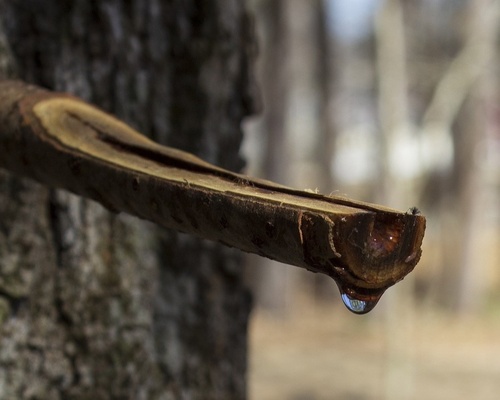
A Spile Diverts Sap from a Sugar Maple Tree – Image by MGosv1830 from Pixabay
The sugar maple is Vermont’s state tree and an iconic symbol of the Green Mountain State. This magnificent tree is best known for its sweet sap. This sap is harvested in the early spring to make one of Vermont’s most famous exports: maple syrup. The process begins when temperatures shift between freezing at night and warmer during the day. This causes the sap in the trees to flow. Skilled sugar makers will then tap the trees and collect the clear, watery sap, which is then boiled down in sugar houses. It’s a labor-intensive process: about forty gallons of sap make just one gallon of syrup! Some producers will take the process further, evaporating the syrup to create maple sugar, a concentrated form of the sweet treat. The sugar maple is not only prized for its sap but also its long life and patience. These trees have a remarkable life cycle; they rarely flower until they reach twenty-two years old. However, they can live up to three to four hundred years. This combination of economic value, cultural significance, and long life makes the sugar maple a fitting representation of Vermont’s heritage and its connection to the land.
The red clover , Vermont’s state flower, is a versatile plant that is integral to the state’s farming. It’s grown throughout the state, serving as both a nutritious feed and a ground cover crop. Its high protein content and ability to be easily digested makes it great food for cattle and horses. This makes it extremely important for Vermont’s dairy industry. It also works very well as a cover crop; it adds nutrients to the soil, keeps the soil from eroding, and keeps weeds in check. It reduces the need for artificial fertilizers and makes the soil healthier. The plant’s pink-to-red flower heads not only add beauty to Vermont’s fields and meadows but also support local pollinators like bees and butterflies. With all these uses, the red clover perfectly represents Vermont’s farming history and its focus on sustainable farming. It’s a small plant that makes a big difference in the Green Mountain State.
Mid-Atlantic
Moving south from New England, we now enter the Mid-Atlantic region. From New York’s bustling cities to Maryland’s scenic Chesapeake Bay, this region is a patchwork of landscapes and cultures. Follow along as we explore the chosen symbols of the mid-Atlantic states and the unique story each one tells of the region’s natural history. From the sugar maple of New York to the mountain laurel of Pennsylvania, these symbols offer insight into the Mid-Atlantic’s rich history, nature, and culture.
DELAWARE
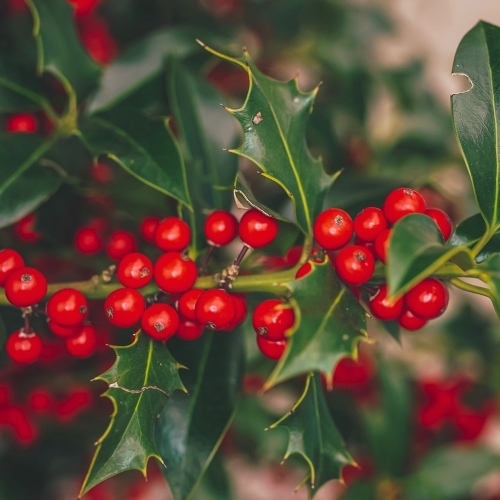
An American Holly Branch with Berries – Image by Gaimard on Pixabay
The American holly, Delaware’s state tree since 1939, is more than just a pretty face in the forest. This tree played an important role in Delaware’s economy and culture. Its glossy leaves and bright red berries made it a popular choice for creating holly wreaths. Selling these leaves was a good way for many people in Delaware to earn money, especially during the winter. Besides its pretty looks, the American holly has also been used as medicine; Some people would use the leaves of this tree to make a tea, which they believed could ward off colds and more. While we may not rely on holly tea for our health these days, this story shows just how important this tree was to the people of Delaware. Today, the American holly stands tall as a symbol of the state’s beauty and the resourcefulness of its people. It reminds us that in Delaware, even the trees have a story to tell.
The peach blossom has been Delaware’s state flower since 1895. This pink flower represents the state’s once-thriving peach industry. At its peak in the 1870s, Delaware grew more peaches than any other state in the country, earning the nickname, “The Peach State.” The peach blossom has five petals and appears in early spring, covering peach trees in a soft pink and signaling the arrival of warmer weather. Although Delaware doesn’t grow as many peaches as it used to, the peach blossom continues to hold a special place in the heart of the Peach State. It serves as a reminder of Delaware’s farming history and the importance it once held. Today, the peach blossom not only graces gardens throughout the state but also serves as a beloved signal that spring has sprung in the First State.
MARYLAND
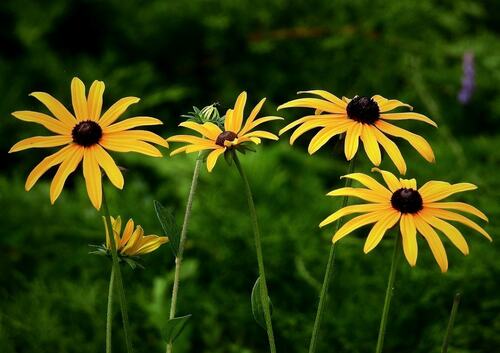
Blooming Black-Eyed Susan Flowers – Image by Pixabay
Maryland’s state tree, the white oak , is a true titan of the forest, standing as a living testament to the state’s enduring spirit. Known for its impressive size and broad, rounded crown, the white oak can grow up to one hundred feet tall and live for several centuries, with some specimens known to be over six hundred years old. Its distinctive bark is light gray and scaly, while its leaves are characterized by rounded lobes that turn beautiful shades of red or burgundy in the fall. The white oak plays a crucial role in Maryland’s ecosystems, providing food and shelter for a wide variety of wildlife, including deer, squirrels, and numerous bird species. Its acorns are also especially important as food for these animals. Historically, the wood from the White Oak has been prized for its strength, durability, and resistance to rot, making it valuable for shipbuilding, furniture, and barrel making. In fact, part of the USS Constitution, “Old Ironsides” herself, was fashioned from white oak. Chosen as the state tree in 1941, the white oak embodies Maryland’s natural beauty, its maritime heritage, and the resilience of its people.
The black-eyed Susan, Maryland’s state flower, is a cheerful and tough wildflower. It brightens the landscape with its golden petals and distinctive dark-brown center. The black-eyed Susan blooms from June to October in meadows, in prairies, and near roads across the state. It can grow from one to three feet tall and is known for its ability to thrive in many different conditions. The flower’s name comes from its appearance, with its dark center looking like a black eye. Besides its looks, the black-eyed Susan plays an important role in nature, providing nectar for pollinators like bees and butterflies as well as seeds for birds. Native Americans have also used parts of this plant for medicine. Chosen as the state flower in 1918, the black-eyed Susan has become a beloved symbol of Maryland. We can see this with how often it can be seen in gardens and in other state imagery. In essence, this bright flower embodies the spirit of Maryland itself—friendly and welcoming like its yellow petals, with a core as strong as its namesake, “black eye.”
NEW JERSEY
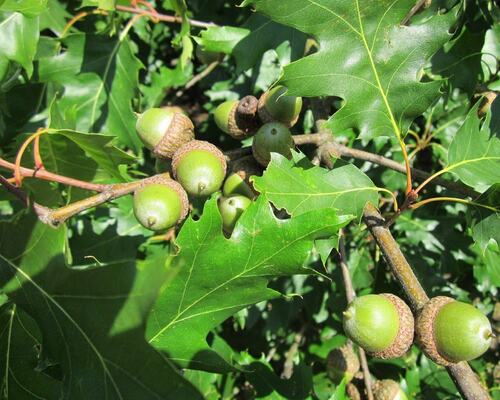
The Leaves & Acorns of the Red Oak – Image by WikimediaImages from Pixabay
The red oak, also known as the northern red oak, was designated as New Jersey’s state tree in 1950. This majestic tree is native to North America and is widely distributed throughout New Jersey’s forests and cities. Red oaks are known for their impressive size, often growing to heights of sixty to seventy-five feet, with some specimens reaching over one hundred feet tall. In the fall, its leaves turn bright red, making New Jersey’s autumn scenery look beautiful. Red oaks are important to the ecosystem too, providing habitats and food for wildlife like deer, squirrels, and many kinds of birds. The tree’s acorns were also historically important to Native American tribes in the region. Additionally, the wood of the red oak is prized for making furniture, flooring, and construction due to its strength and attractive grain. The reddish-brown color of its wood is where the tree’s name comes from. While red oaks are generally healthy and long-lived, they can sometimes have problems with diseases or insects. This tree shows us how one plant can be important for both nature and people and reminds us of New Jersey’s forests and history.
The common blue violet was adopted as New Jersey’s state flower in 1971. This delicate herb is native to eastern North America and can be found almost anywhere in the state. The violet usually blooms in early spring with small blue-violet-colored flowers. These flowers can also range from deep purple to nearly white. The plant also has unique heart-shaped leaves that are widely known. Though it may be tiny, the violet provides important early-season nectar for pollinators like bees and butterflies. People have found lots of uses for violets over the years. Their flowers are edible and have been used to decorate salads or even candied as sweet treats! The plant was also used in folk medicine to treat everything from headaches to breathing problems. While violets are good at growing in many places, they can sometimes be seen as weeds in gardens. This little flower reminds us that even small things in nature can be both beautiful and useful. It also shows us how a common plant that many people might overlook can become an important symbol for a whole state.
NEW YORK

A Fully Bloomed Red Rose – Photo by Yohei Kato
New York’s state tree, the sugar maple , is a big, beautiful tree that’s famous for two things: its colorful fall leaves and its sweet sap. This iconic tree is native to the northeastern United States and is a dominant species in many of New York’s forests. It was designated as New York’s state tree in 1956. In autumn, its leaves turn bright yellow, orange, and red, making New York’s forests look spectacular. But what makes sugar maples special is the sap inside them. People collect this sap and boil it down to make maple syrup, which is a big business in New York. Native Americans taught early settlers how to do this long ago. Sugar maples are useful in other ways too. Their wood is great for making furniture and even musical instruments. Many animals also depend on these trees for food and homes. While sugar maples are generally hardy, they can have problems with certain insects and diseases, and climate change might affect where they can grow in the future. This tree shows us how nature can be both beautiful and useful and reminds us of New York’s forests, history, and tasty syrup!
While the sugar maple represents New York’s splendor, another plant celebrates its diversity. New York’s state flower is the rose, but not just one kind—all types of roses! This choice reflects the diversity and widespread cultivation of roses throughout the state. Roses have been cultivated for thousands of years and are beloved for their beauty, fragrance, and symbolic significance. In New York, growing and selling roses is also a big business. Roses are part of many New York traditions, like a special Rose Day at the state capitol building. The flower’s association with love, beauty, and resilience makes it a fitting symbol for New York State. Additionally, the rose’s ability to thrive in diverse environments mirrors the adaptability and resilience of New Yorkers themselves. It reminds us that something can be both wild and carefully grown and still be equally important.
PENNSYLVANIA
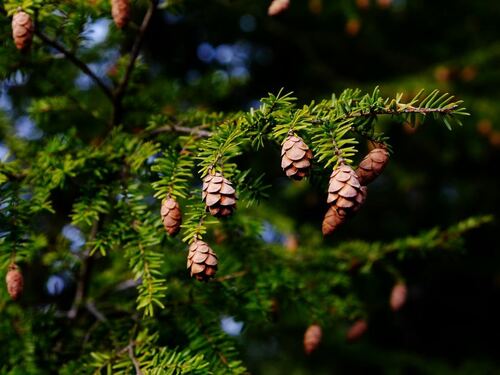
Branches & Cones of an Eastern Hemlock - Image by jw432 from Pixabay
Meet Pennsylvania’s state tree, the eastern hemlock—a true forest elder that’s been around since 1931 (as the state tree, that is). These evergreens are like living time capsules, potentially lasting up to one thousand years and becoming vital homes for countless forest critters along the way. But even these hardy giants face challenges. The hemlock woolly adelgid, an invasive insect from Asia first discovered in the eastern United States in the 1950s, has become a significant concern. This tiny pest feeds on the tree’s sap, causing needle loss, branch dieback, and eventually death. Woolly adelgid infestations can reduce a hemlock’s lifespan from centuries to mere decades, potentially altering Pennsylvania’s forest composition and the numerous ecological relationships that depend on these long-lived giants. The good news? People are stepping up to help. Scientists and nature lovers are working to protect these iconic trees, hoping to keep the eastern hemlock standing tall in Pennsylvania’s woods for generations to come. It’s a reminder that even the mightiest trees sometimes need a helping hand from their human neighbors.
The mountain laurel is the official state flower of Pennsylvania, chosen for its beauty and prevalence throughout the state. This shrub is native to the eastern United States and thrives in Pennsylvania’s woodlands and mountain regions. The Laurel Highlands, a scenic area in southwestern Pennsylvania, is named after this iconic flowering plant, highlighting its cultural and ecological significance to the state. While it’s loved for its beauty, mountain laurel plays a bigger role in nature, too. Growing up to twenty feet tall, it creates dense thickets where wildlife can hide and live. It usually blooms in late spring to early summer, producing clusters of delicate star-shaped flowers ranging in color from white to pink. These blossoms, each about an inch in diameter, create a stunning display against the plant’s leathery dark-green leaves. Native Americans and early settlers found uses for the plant, but here’s the catch—it’s actually poisonous if eaten. This reminds us that even beautiful plants can have a dangerous side. And while it’s cherished in the wild, its toxicity means we need to be careful about planting it where kids or pets might munch on it. The mountain laurel’s story shows us how a plant can be both beautiful and complex, just like the state it represents.
In Conclusion
As we’ve explored the Northeast’s state trees and flowers, we’ve discovered that these plants are more than just symbols—they’re living pieces of history that tell us about the region’s nature and culture. From Connecticut’s Charter Oak to Vermont’s sugar maple, these plants play important roles in local environments and communities. They also remind us of our duty to protect nature. We encourage readers to share their own experiences with these state symbols! Your stories help add to our understanding of America’s natural legacy. By appreciating these plants, we strengthen our bonds with the land and with each other. Their resilience can inspire us as we face our own future challenges.
Check out the rest of this blog series!


